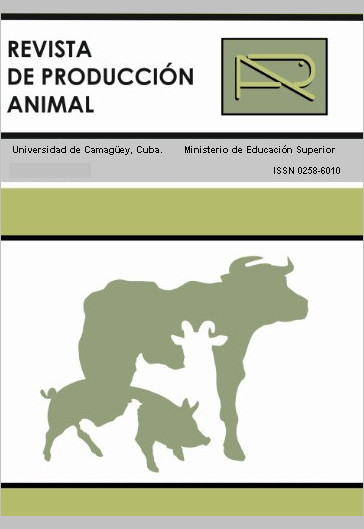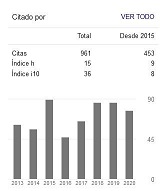Model Comparison to Interpret the Kinetics of in vitroGas Production with Bovine Excreta Used as Inoculum.
Resumen
New models to help interpret the kinetics of in vitrogas production with bovine excreta used as inoculum were suggested. Samples of L. leucocephala, G. sepiumand P. maximum, with different gas production profiles, were used. The samples were submitted to the procedure for gas production and the volumes were determined every 3 h, in the first 30 h; then at 36; 48; 72 and 96 h. Five models were compared (two monophase and three biphase), and the parameters for better adjustment were determined. Mean squared error and the Durbin-Watson test were used as comparison criteria. It was concluded that the monophase models fall short to describe the kinetics of in vitrogas production with bovine excreta; whereas the biphase models with simple exponential components are useful. The biphase equation, where V = 0 for t < L and V = B * (1 – EXP (- C * (t - L))) for t ≥L classified as the most useful work is done with syringes.Descargas
Citas
CORREA, H. J. (2004). RUMENAL: Procedimiento para estimar los parámetros de cinética ruminal mediante la función Solver de Microsoft Excel. Rev. Col. Cienc. Pec.,17 (3), 2004.
FRANCE, J.; LOPEZ, S.; KEBREA, E.; BANNINK, A.; DHANOA, M. S. y DIJKSTRA, J. (2005). A General Compartmental Model for Interpreting Gas Produc-tion Profiles. Animal Feed Science and Technology, 123(2), 473-485.
HERNÁNDEZ, J. E. (2006). Valoración de la caprino-cultura en la Mixteca Poblana: socioeconomía y recursos arbóreo-arbustivos. Tesis de doctorado en Ciencias Veterinarias, Universidad de Camagüey, Cuba.
JAY, O. y TORRES, V. (2007). Bondad de ajuste y supuestos básicos en la modelación de la degradación ruminal de forraje de CT-115. II Congreso In-ternacional de Producción Animal Tropical, ICA, La Habana.
KEIR, B.; LAI, N. V.; PRESTON, T. R. y ØRSKOV, E. R. (1997). Nutritive Value of Leaves from Tropical Trees and Shrubs: 1. In vitroGas Production and in sacco Rumen Degradability. Livestock Research for Rural Development, 9 (4).
LA O, O. (2001). Contribución al estudio del valor nutritivo de diferentes ecotipos del género Leucaena para la alimentación de rumiantes. Tesis de docto-rado en Ciencias Veterinarias, Instituto de Ciencia Animal, Universidad Agraria de La Habana, Cuba.
MARTÍNEZ, S. J.; PEDRAZA, R. M.; RESÍLLEZ, A.; GUEVARA, G.; GONZÁLEZ, CECILIA y LEÓN, MARLENE (2008). Correlación entre la degradabili-dad ruminal in situy la producción de gas in vitro con el uso de heces vacunas depuestas como inóculo. Rev. prod. anim., 20 (2), 110-114.
MARTÍNEZ, S. J. (2005). Implementación de la técnica de producción de gas in vitrocon heces vacunas como inóculo y su empleo para evaluar el follaje de algunas leguminosas arbustivas. Tesis de maestría en Producción Bovina Sostenible, Facultad de Ciencias Agropecuarias, Universidad de Camagüey, Cuba.
MCDONALD, I. (1981). A Revised Model for the Estimation of Protein Degradability in the Rumen. J. Sci. Agric. Camb., 96, 251-252.
ØRSKOV, E. R. y MCDONALD, I. (1979). The Estimation of Protein Degradability in the Rumen from Incubation Measurements Weighted According to Rate of Passage. Journal of Agricultural Science, 92, 499-503.
PEDRAZA, R. M. (1998). Use of in vitro Gas Production Technique to Assess the Contribution of Both Soluble and Insoluble Fractions on the Nutritive Value of Forages. Tesis de maestría, Universidad de Aberdeen, Escocia.
POSADA, S. L. y NOGUERA, R. R. (2007). Comparación de modelos matemáticos: una aplicación en la evaluación de alimentos para animales. Revista Colombiana de Ciencias Pecuarias. Extraído en julio de 2007, desde http://rccp.udea.edu.co/v_actual/.
RYMER, C.; HUNTINGTON, J. A.; WILLIAMS, B. A. y GIVENS, D. I. (2005). In vitroCumulative Gas Production Techniques: History, Methodological Considerations and Challenges. Animal Feed Science and Technology, 25(2), 9-30.
VAN LAAR, H.; VAN STRAALEN, W. M.; VAN GELDER, A. H.; DE BOEVER, J. L.; D’HEER, B.; VEDDER, H.; KROES, R.; DE BOT, P.; VAN HEES, J. y CONEB, J. W. (2006). Repeatability and Reproducibility of an Automated Gas Production Technique. Animal Feed Science and Technology, 27 (2), 133-150.
Los autores de los artículos publicados en RPA retienen los derechos de autor de su trabajo, de marca y patente, y también sobre cualquier proceso o procedimiento descrito en el artículo, así como a compartir, copiar, distribuir, ejecutar y comunicar públicamente el artículo publicado en la RPA o cualquier parte de aquel siempre que indiquen la fuente de publicación (autores del trabajo, revista, volumen, número y fecha), pero están de acuerdo en que la revista publique los trabajos bajo una licencia Creative Commons.
![]() Licencia Attribution-NonCommercial 4.0 International (CC BY-NC 4.0)
Licencia Attribution-NonCommercial 4.0 International (CC BY-NC 4.0)






































